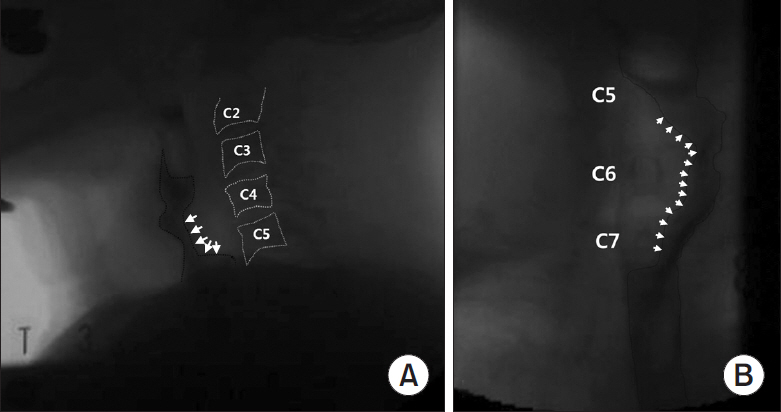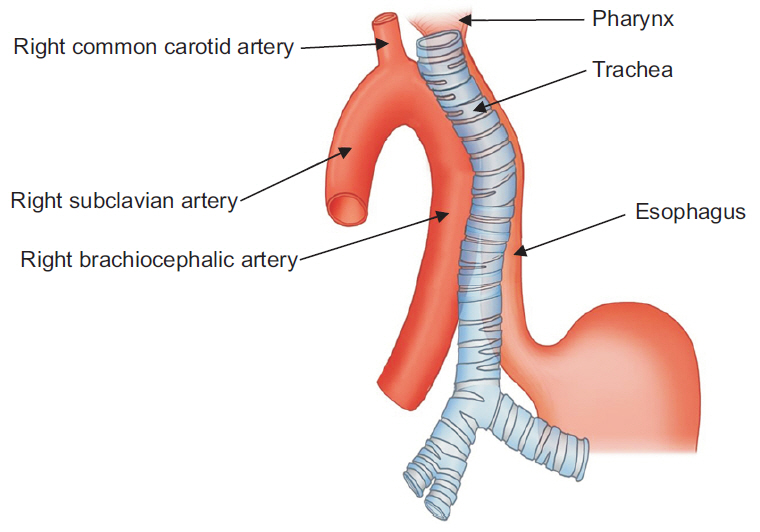Ann Rehabil Med.
2021 Feb;45(1):79-82. 10.5535/arm.20057.
Unusual Pharyngo-Esophageal Dysphagia Caused by a High-Riding Right Brachiocephalic Artery
- Affiliations
-
- 1Department of Rehabilitation Medicine, Kangwon National University Hospital, Chuncheon, Korea
- 2Department of Rehabilitation Medicine, Kangwon National University School of Medicine, Chuncheon, Korea
- KMID: 2513233
- DOI: http://doi.org/10.5535/arm.20057
Abstract
- High-riding right brachiocephalic and subclavian arteries are often asymptomatic and rare vascular variations. We present a patient with high-riding right brachiocephalic and subclavian arteries that caused compressive pharyngeal and cervical esophageal dysphagia. An 82-year-old woman presented to our hospital with dysphagia that worsened with solid food. A pulsatile lump was observed on the right neck side. A videofluoroscopic swallowing study showed a deviated food bolus movement anterolaterally from the normal vertical pharyngoesophageal transition, with a filling defect in the lower pharynx through the upper esophagus. Neck computed tomography (CT) showed high-riding right brachiocephalic and subclavian arteries and a tortuous right common carotid artery located adjacent to the trachea in the cervical area. The cervical midline structures were deviated to the left neck side. A neck mass with vascular variation should be considered as a cause of dysphagia that worsens with solid food; CT should be considered to determine its cause.
Figure
Reference
-
1. Groher ME, Bukatman R. The prevalence of swallowing disorders in two teaching hospitals. Dysphagia. 1986; 1:3–6.
Article2. Gupta V, Niranjan K, Rawat L, Gupta AK. Stent-graft repair of a large cervical internal carotid artery pseudoaneurysm causing dysphagia. Cardiovasc Intervent Radiol. 2009; 32:558–62.
Article3. Gupta A, Winslet MC. Tortuous common carotid artery as a cause of dysphagia. J R Soc Med. 2005; 98:275–6.
Article4. Gamache FW Jr, Voorhies RM. Hypertrophic cervical osteophytes causing dysphagia: a review. J Neurosurg. 1980; 53:338–44.5. Bakheit AM. Management of neurogenic dysphagia. Postgrad Med J. 2001; 77:694–9.
Article6. Carucci LR, Turner MA. Dysphagia revisited: common and unusual causes. Radiographics. 2015; 35:105–22.
Article7. Upadhyaya PK, Bertellotti R, Laeeq A, Sugimoto J. Beware of the aberrant innominate artery. Ann Thorac Surg. 2008; 85:653–4.
Article8. Dua SG, Purandare NC, Pramesh CS. Incidental detection of high-riding innominate artery and bilateral retropharyngeal carotid arteries: radiological findings and clinical relevance. Clin Radiol. 2011; 66:685–7.
Article9. Chegar BE, Emko P. Bilateral vocal cord paralysis secondary to esophageal compression. Am J Otolaryngol. 2004; 25:361–3.
Article




